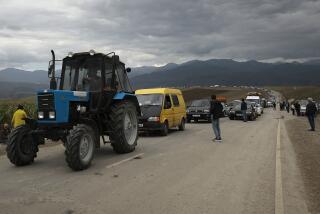MOVIE REVIEW : ‘Ararat’ Examines the Armenian Holocaust
- Share via
“Back to Ararat” (Los Feliz) is a Swedish documentary about one of the most horrible and piteous events of this century: the forced deportation and slaughter of vast numbers of Armenian people by the government of Turkey in April, 1915, during World War I. This appalling event reverberates like the echo of some hideous cataclysm over the entire film.
Eyewitnesses recount gruesome forced marches, families riven apart, mass executions. They tell of thousands of people herded into caves to be burned alive by Turkish soldiers, of the handful of survivors crawling their way out of the carnage, forced to sustain themselves for days on the burnt human flesh all around them.
As a counterpoint to these recollections, we visit the descendants of those victims and Armenia as it is today: the small wedge--one-sixth of the old land mass--of Soviet Armenia and the rest of the old Turkish-ruled country, near Ararat and the sea. It’s a halcyon-seeming but very empty-looking place, where barely a handful of Armenians now exist. Yet it’s the touchstone for many of the displaced people we meet.
Directors PeA Holmquist and collaborators Jim Downing and Suzanne Khardalian interview them everywhere: in Decines, France (near Lyon), New York City, Boston, Fresno or Bourdj Hamoud in Beirut. A pattern emerges. The older Armenians, some of them actual refugees from the terror, try to accept, forget or somehow transcend the past. Many of the younger Armenians, furious, talk of revenge or reclaiming the turf, even cultivate a pseudo-military tough-guy facade.
Representatives of Turkey appear, too. Here, as with some of the scenes of the Armenian “Young Turks,” the movie is at its most disturbing. Few histories cast any doubt on the Turkish army’s wholesale massacre of the Armenian citizenry. Yet these representatives vehemently lecture young Turkish-Americans in workshops, or blandly address the camera, exuding an air of wounded reason, their eyes shifting or glazing over.
They all agree: there was no massacre. A huge mistake. The explanation for the disappearance or scattering of over a million people? It was a war, full of mass confusion, bloodshed, people running here and there, getting killed. Who could keep track? It was nobody’s fault. It was awful. And the worst victims of all, one spokesman blandly assures us, were the Turks themselves, maligned for something they never did.
“Back to Ararat” is well shot by Holmquist and his crew, and beautifully scored to the mournful tunes of Armenian composer Komitas, who never composed again after the massacre. It’s difficult to watch it without a sense of outrage: not directed against the Turkish people, but against the brutal tyrants who ruled over them in 1915 and hatched the inhuman stratagem of emptying an entire land. And it’s hard not to feel anguish, not just for for the million or more Armenians, but for every helpless group of people in the history of this world, whether Armenians, European Jews, Ukrainians, American Indians, Africans or Cambodians, crushed in the juggernaut of politics, enslaved or slaughtered by callous, cruel and vain leaders who believe themselves above the law and humanity.
“Back to Ararat” (Times-rated: Mature, for adult themes and content) should probably be seen by every person of Armenian and Turkish descent in this city. (In a strange way, one hopes it might reconcile them, at least in a mutual recognition of this terrible history.) And it should be seen as well by those of us who may forget the sheer murderous enormity of what our leaders sometimes do in the name of history’s necessity and their nation’s rightful destiny.
More to Read
Only good movies
Get the Indie Focus newsletter, Mark Olsen's weekly guide to the world of cinema.
You may occasionally receive promotional content from the Los Angeles Times.










